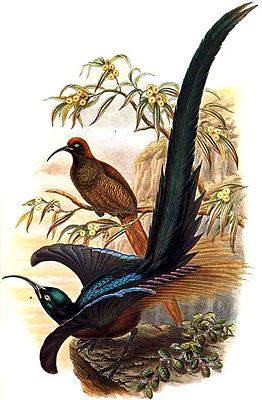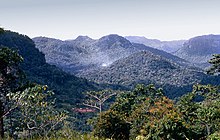Epimachus (genus)
| Epimachus | ||||||||||||
|---|---|---|---|---|---|---|---|---|---|---|---|---|

Narrow-tailed paradise hop ( Epimachus meyeri ) |
||||||||||||
| Systematics | ||||||||||||
|
||||||||||||
| Scientific name | ||||||||||||
| Epimachus | ||||||||||||
| Cuvier , 1816 |
Epimachus is a genus from the family of the birds of paradise (Paradisaeidae) and includes only two species . Both species occur exclusively in New Guinea.
In the Red List of Threatened Species of the IUCN , the broad-tailed paradise hop is listed as endangered ( vulnerable ). This makes it one of the most endangered bird of paradise species. The narrow-tailed paradise hop , on the other hand, is not considered endangered ( least concern ). Both species are listed in Appendix II of the Washington Convention on the Protection of Species .
features
In both species of the genus Epimachus , the middle pair of control feathers is greatly elongated and extends far beyond the rest of the tail plumage, its length corresponds to 133 to 165 percent of the wing length. Including this extended pair of control springs, they reach body lengths of 110 and 95 centimeters. The beak is narrow, long and curved slightly sickle-shaped in both species. In both sexes, it is more than twice as long as the head. The nostrils are free of feathers, but the fletching begins immediately behind the nostrils. The gender dimorphism is very pronounced.
Adult birds
The males have a predominantly velvety black plumage, in which individual parts are very iridescent. The streak of scale-like feathers that run along the upper middle of the body and iridescent metallic blue-green is particularly striking. The line is continued on the tail plumage, which in both species also has a pronounced metallic sheen. Further characteristics of the males are the elongated feathers on the sides of the body. The tail is otherwise tiered in both sexes and becomes narrower in a V-shape.
In females, the middle pair of control feathers is also elongated, but it only protrudes slightly beyond the rest of the tail plumage. Overall, they are much less conspicuous in color than the males and are very similar to one another. Their plumage is brownish and dark brown stripes on the underside of the body.
Fledglings
Young birds of both sexes initially resemble the female. In the young male birds, the plumage of the adult males only gradually shows up and takes several years, as has been demonstrated in captive birds: A male of the narrow-tailed paradise hop that on September 13, 1978 the Baiyer River Sanctuary , Papua New Guinea, was handed over and which initially still showed the plumage of a female, in July 1982 for the first time heard the jackhammer-like call typical of the males. A year later it began to show the first feathers from an adult male. This individual only wore the full plumage of a male in May 1985. This leads to the conclusion that males only show the plumage of adult males at the age of seven to eight years.
Distribution area of the species and subspecies as well as habitat
Both species belong to the birds of paradise with a comparatively large distribution area: It extends from the Vogelkop , a peninsula in the extreme northwest of New Guinea, over the plateaus in eastern New Guinea to the southeastern tip.

The individual species and subspecies inhabit the following regions:
-
Broad-tailed paradise hop ( Epimachus fastosus ). Occurrence from Vogelkop to the plateaus in eastern New Guinea. It is missing on the southeastern peninsula.
- E. f. fastosus ( Hermann , 1783) - nominate form found on the Vogelkop (Tamrau Mountains and Arfak Mountains) in northwest New Guinea.
- E. f. atratus ( Rothschild & EJO Hartert , 1911) - Mountains of the Wandammen Peninsula and the mountain ranges in the central interior of New Guinea to the Kratke Range in eastern New Guinea
- E. f. ultimus Diamond , 1969 - Bewani Mountains and Torricelli Mountains in northern New Guinea.
-
Narrow-tailed paradise hop ( Epimachus Meyer ): The narrow-tailed paradise hop is missing on the bird's head. Its distribution area extends from the Weyland Mountains in central New Guinea to the southeastern tip of New Guinea.
- E. m. albicans (van Oort, 1915) - Central Mountains of New Guinea from the Weyland Mountains in the west to the Hindenburg Mountains and the Victor Emanuel Mountains.
- E. m. bloodi Mayr & Gilliard, 1951 - Mountains in Eastern New Guinea, the range includes the Hagen Mountains as possibly the most westerly range, Mount Giluwe and the Kraetkegebirge .
- E. m. Meyer Finsch & AB Meyer, 1885 - Mountains in southeast New Guinea, including the Owen Stanley Mountains .
Both species occur only in mountain forests. The Breitschwanz-Paradieshopf predominantly settles at altitudes between 1800 and 2150 meters. Occasionally it is also found at altitudes of 1280 meters and at altitudes of up to 2550 meters. Where the range of the broad-tailed bird of paradise overlaps with that of the closely related narrow- tailed paradise hop, the broad-tailed paradise hop populates the lower altitudes. The main distribution of the narrow-tailed bird of paradise, on the other hand, is at altitudes between 1900 and 2900 meters above sea level, but it still occurs occasionally at 3200 meters.
Way of life
Both species eat fruits and arthropods. The narrow-tailed paradise hop also eats small vertebrates; this is only suspected in the less well-researched broad-tailed paradise hop. They find their food mainly in the treetop area. To get to arthropods, they also tear pieces of bark and epiphytes from the trees. While searching for food, they hop from branch to branch or climb up the tree trunks. Both types regurgitate pips and stones from fruits. Basically, the adult males live more secretly than the females.
Reproduction
Like the vast majority of birds of paradise, both species are polygynous , which means that the male mates with several females if possible. The respective female raises the offspring alone. The males each defend a large area in which one or more traditional courtship areas are located. These courtship areas are individual waiting areas high up in the treetop area. In the wild, the male's courtship has not yet been observed.
Hybrids with other birds of paradise
The tendency of birds of paradise to cross with other species in their family was already described by Anton Reichenow at the beginning of the 20th century and thus almost earlier than for any other bird family. It is mostly the males who stand out with their very different plumage. Occasionally they are initially described as a distinct species. The type specimen , which was originally described as Pseudastrapia lobata , is now considered a cross between the long-tailed paradigalla and the broad-tailed bird of paradise. Another specimen emerged from a cross between the broad-tailed paradise hop and the collar paradise bird . The collar bird of paradise is one of the species that mates with another species more often than any other bird of paradise species. Crossings are described less frequently for the narrow-tailed paradise hop. However, a mating of a male of the narrow-tailed paradise hop with a narrow-tailed paradise magpie was observed in 1962 , from which a nestling emerged. However, this died at the age of 10 days.
Epimachus species and human
hunt
The feathers of both types are made into traditional head and body jewelry by indigenous peoples of New Guinea. The feathers are sometimes given considerable value: in the 1990s, 250 kina were paid for one hide of the broad-tailed paradise hop in the area around the Ok Tedi opencast mine , a gold and copper mine in Papua New Guinea , while at the same time in In this region the hides of other bird of paradise species were traded for 5 to 20 kina. The hunting pressure on the Breitschwanz-Paradieshopf increased considerably due to the development of the mine, because rifles were also imported into the region. In other regions a hunting ban was issued in the 1990s, where - after some men were punished for killing broad-tailed paradise hops - the population of this species recovered dramatically in some cases. Basically, however, this species is seriously endangered wherever the population living in the highlands increases. This can also be seen in a direct comparison with the narrow-tailed paradise hop. This is also hunted by the indigenous people of New Guinea because of its striking decorative feathers and can be rare in regions with suitable living conditions if the hunting pressure is correspondingly high there. However, the narrow-tailed Paradieshopf is a comparatively more common bird than the broad-tailed Paradieshopf because it inhabits higher areas than the Breitschwanz-Paradieshopf and thus occurs in regions that are far above the agricultural areas and gardens of the indigenous population.
Imprisonment
Broad-tailed birds of paradise have rarely been kept in captivity. The first pair of narrow-tailed paradise hops, on the other hand, was held in the private collection of EJ Brooks at Hoddom Castle as early as 1909 . Since then, individuals of this species have been shown several times in zoological gardens. Some individuals have been described as extremely tame and very quickly took food from their keepers' hands. They need large indoor aviaries and are considered a species that is relatively easy to keep. However, they tend to use their beak to examine all objects in their aviary and injure their beak in the process.
literature
- Bruce M. Beehler, Thane K. Pratt: Birds of New Guinea; Distribution, Taxonomy, and Systematics . Princeton University Press, Princeton 2016, ISBN 978-0-691-16424-3 .
- Clifford B. Frith, Bruce M. Beehler : The Birds of Paradise - Paradisaeidae. Oxford University Press, Oxford 1998, ISBN 0-19-854853-2 .
- Eugene M McCarthy: Handbook of Avian Hybrids of the World. Oxford University Press, Oxford 2006, ISBN 0-19-518323-1 .
Web links
Single receipts
- ↑ Handbook of the Birds of the World on Breitschwanz-Paradieshopf , accessed on August 2, 2017
- ↑ Handbook of the Birds of the World zum Schmalschwanz-Paradieshopf , accessed on August 6, 2017
- ↑ a b Frith & Beehler: The Birds of Paradise - Paradisaeidae . P. 357.
- ↑ a b Frith & Beehler: The Birds of Paradise - Paradisaeidae . P. 376.
- ↑ Frith & Beehler: The Birds of Paradise - Paradisaeidae . P. 359.
- ↑ a b Frith & Beehler: The Birds of Paradise - Paradisaeidae . P. 367.
- ↑ a b c Frith & Beehler: The Birds of Paradise - Paradisaeidae . P. 375.
- ^ McCarthy: Handbook of Avian Hybrids of the World . P. 228.
- ^ A b McCarthy: Handbook of Avian Hybrids of the World . P. 229.
- ↑ Frith & Beehler: The Birds of Paradise - Paradisaeidae . P. 347.
- ↑ a b Frith & Beehler: The Birds of Paradise - Paradisaeidae . P. 365.


